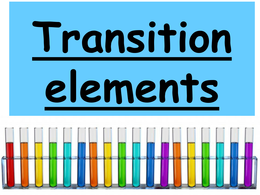Transition
elements
, The d block elements
The d block elements are all metallic so have high B.P & M.P, are
shiny & conduct electricity & heat.
Uses
• Copper, silver & nickel- used in coinage
• Iron- used in construction & tool production
• Copper- used in electrical cables & water
pipes
• Titanium- used in aerospace industry.
From scandium to copper each element has an extra electron
which fills the 3d subshell. This is with the exception of chromium
& copper which do not follow the expected principle for placing
electrons singly in orbitals before pairing.
• Chromium: 1s2, 2s2, 2p6, 3s2, 3p6, 4s1,3d5
• Copper:1s2, 2s2, 2p6, 3s2, 3p6, 4s1,3d10
This is because it is more energetically stable to have a ½ filled
3d & 4s orbital as all of the electrons are spinning in the same
direction so there is less repulsion. It is also more stable to have
10 electrons in a 3d orbital & 1 in a 4s orbital.
, Transition metals
Transition elements are d-block elements that form at least 1 ion
with a partially filled d-orbital. Although Sc & Zn are d-block
elements, they do not match this definition & are not classified as
transition metals.
Scandium only forms the ions Sc3+: Zinc only forms the ions Zn2+:
• Sc: 1s2,2s2,2p6,3s2,3p6,4s2,3d1 • Zn: 1s2,2s2,2p6,3s2,3p6,4s2,3d10
• Sc3+ :1s2,2s2,2p6,3s2,3p6 • Zn2+:1s2,2s2,2p6,3s2,3p6,3d10
Sc3+ ions have an empty d orbitals & Zn ions have a full d-orbital,
so they do not form ions with a partially filled d-orbital.
The transition elements have a number of characteristic
properties that are different from other metals:
They form compounds in which the transition element has
different oxidation states
They form coloured compounds
The elements & their compounds can act as catalysts
2 ions are isotonic if they have the same electronic configuration




